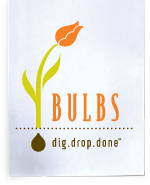Container Gardening
A perfectly placed pot or container with even just a few flowers can instantly perk up any spot, which might explain why they're a favorite of city terraces and balconies. There are hundreds of attractive ways to use containers and you only have to keep in mind that your plant choices will need to tolerate wind. Lower-growing crocus, scilla, chionodoxa and grape hyacinths are great choices, along with shorter tulips and rock garden daffodils.
When planting your container in the fall, there are a variety of ways to plant them depending on your intended effect:
- For massive color effect, plant with a single variety of bulbs
- For continuous spring color, plant several kinds of bulbs that have successive flowering periods. Use the "lasagna technique" of planting bulbs in multiple layers, with early-flowering bulbs in the upper layer and bulbs that flower later and last in the middle and deepest layers.
- For a "mini-garden" effect, choose multiple containers and pots of various sizes and fill them with the colors and bulbs of your choice
Terracotta pots, plastic planters, molded fiberglass planters, wooden half-barrels, wicker baskets, ceramic pots, old wooden wagons, wheelbarrows, and even tires — all make for useful decorative containers. If you have more than one pot, group them together for greater visual effect and to make watering more convenient.
To plant in containers, follow these simple steps:
Step 1: Buy soil
Commercial potting mixes like those sold at most hardware stores and home and garden centers are the best soil for container plantings. Generally, they're richer, cleaner, more insect- and disease-free and lighter in consistency than most garden soil. Most important, potting soil retains water for a long time, which keeps flowering bulbs from drying out during growth and flowering. Replace the soil every growing season or, if you plant bulbs as tub plants, be sure to enrich the soil with a fertilizer tablet in early spring, which will gradually release nutrients to the roots for at least four weeks.
Step 2: Allow for drainage
Be sure to keep the drainage holes clear since plants cannot survive in waterlogged soil.
Step 3: Choose a deep enough container
Check the suggested planting depth on the plant label and be sure your container is deep enough for your selections.
Step 4: Add Soil
Fill the pot 1/4 to 1/3 deep with soil, position plants at the proper depth, then fill in additional soil up to 1" (2.5 cm) below the rim of the pot to allow for watering. Use this top inch for mulch, if needed.
Step 5: Double Potting
You can display the planted container as is or you can "double pot" the container by sinking it into a more decorative one. Be sure water can't collect in the base and drown the inner pot. Either drain as needed or place a brick or inverted saucer in the base to elevate the inner pot.
Plant in Layers: Pots of Perpetual Spring Color
Nothing tells dreary winter that its days are numbered like a cheerful pot of tulips blooming by the front door. But did you know that by layering your container's plantings in fall you can create seemingly perpetual color in spring?
Layering, or planting "lasagna-style," is a technique that lets you enjoy successive waves of bloom in a single container by overlapping the bloom times of early, mid and late-blooming spring bulbs. Any early-mid-late combo will work and one excellent combination is to use crocus, daffodils, grape hyacinths and tulips as the early, mid and late blooming bulbs. In this particular scheme, it's the cobalt blue grape hyacinths with their extremely long bloom season that holds everything together.
Place layered pots where you'll most enjoy them: by doorways, walkways, the mailbox and lampposts, next to the garage or driveway, or even right outside your kitchen window!
The following instructions will help you get started:
Minimize Cold, Wind Exposure
The larger the pot, the greater the protection it provides. To protect bulbs in colder climates where freezing is an issue, choose a whisky barrel-sized pot or larger or place pots in protected areas, such as against a house foundation or inside a garage, until sprouts emerge in early spring. Another technique is to group large pots close together in an area away from wind and extreme cold then wrap the whole group with burlap or other insulating material. If it's simply too cold in your area to protect containers from freezing, don't try over-wintering bulbs in outdoor containers.
Positioning the Bulbs
To plant in layers, pretend you're making lasagna. You'll plant the largest bulbs 8-inches (20 cm) deep and smaller bulbs 5-inches (13 cm) deep with layers of soil under, over and in-between the bulbs. Start by filling the base of the container with potting soil. Measuring from the top rim, allow 2-3 inches (5-7 cm) for mulch and watering then measure an additional 8 inches (20 cm) to position the first layer of bulbs.
At 11 inches (28 cm) below the pot rim, place the tulips and daffodils pointy ends up. Intermix the bulbs so tulips and daffodils are evenly distributed and position them close together, even touching, to maximize bloom from this spot. You don't want bulbs touching the sides of the container since this area is most vulnerable to freezing.
Add 3 inches (8 cm) of soil around and above the first layer.
For your second layer, intermix the smaller bulbs (crocus, muscari) so they're evenly distributed and pack closely together. Don't worry that the growing sprouts will bump into one another because it doesn't happen! Like people rushing along city sidewalks, bulbs tend to grow around one another, swerving slightly out of the way.
Top off with 5 inches (13 cm) of potting soil and water well. Top dress with mulch or even pansies for an appealing touch of winter color.
Three Waves of Spring Color
As spring arrives, sit back and enjoy the show as three waves of colorful bulb flowers come up, bloom and move on:
- 1st wave of bloom, early spring: Crocuses bloom, then fade away.
- 2nd wave of bloom, mid-season: Daffodils and grape hyacinths bloom, then daffodils fade away.
- 3rd wave of bloom, late season: The same grape hyacinths continue to bloom, now joined by tulips. Then, both fade away, completing the display.
The leaves of each wave will remain to bring fullness to the display, although you may wish to snip off the faded daffodil flowers. Don't be tempted to leave the bulbs in the pot if summer flowering bulbs will be planted there next. Routine watering and fertilizing over summer will damage the spring bulbs. Once the tulip flowers fade, it's time to dig up the whole lot and replant everything in a less-conspicuous spot in the yard or garden. Choose a well-drained, sunny spot, such as along a path or side yard at the edge of the property, where the bulbs can slowly die-back. By giving them some fertilizer in fall and again in early spring there's a good chance they'll come back in future years to bloom again and even multiply.



